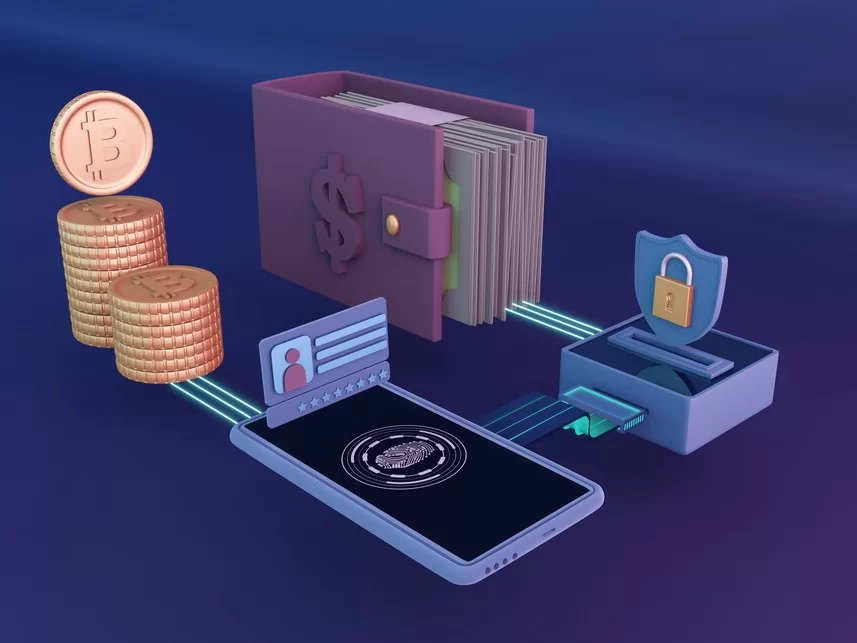- As more traders grow their investment portfolios, the need for safe storage of cryptocurrencies and digital assets rises. Whether they prefer advanced cold wallets for offline security or simple software wallets, having a reliable web3 wallet is essential.
- Web3 wallets are crucial for securely trading and managing digital assets and improving the interoperability of decentralized applications (DApps).
- Different types of web3 wallets offer varying levels of security and convenience, allowing users to choose the one that suits their needs.
- In contrast to custodial wallets, noncustodial web3 wallets let users hold their private keys and fully control their funds.
A web3 wallet is mainly designed for interacting with web3 applications, integrating a user-friendly interface that can easily connect and interact with DApps on various blockchains. It’s also used to store a user’s cryptocurrency, NFTs or other digital assets.
In this article, we’ll delve into the concept of a Web3 wallet, examining its development, essential characteristics, variations, and security aspects. By the conclusion, you’ll have gained a comprehensive understanding of the significance of Web3 wallets within the decentralized web landscape.
The evolution of digital wallets
Over the years, digital wallets have evolved significantly to meet the changing demands and technological advancements. Initially, during the Web1 era, they served a rudimentary function of storing payment information for online transactions. As the internet progressed to Web2, digital wallets expanded their capabilities, enabling users to manage various digital assets like loyalty points and gift cards. Despite these improvements, they remained centralised, with user information controlled by a single entity.
However, with the rise of blockchain technology and cryptocurrencies, a paradigm shift occurred. Modern digital wallets now offer users unprecedented control over their assets, facilitating secure peer-to-peer transactions without intermediaries. This decentralised approach ensures enhanced security and privacy for users. By embracing this evolution, individuals can enjoy greater autonomy in managing their financial assets within the digital realm.
Also read: Blast Network integration expands Binance Web3 wallet features
Also read: Circle Unveils Web3 Wallet: Introducing the Programmable Wallet Revolution
What is a Web3 wallet?
At its core, a Web3 wallet is a software program that stores private keys, which are necessary for accessing blockchain networks and conducting transactions. Unlike traditional wallets, which store physical currency, Web3 wallets store digital assets such as Bitcoin, Algorand, and NFTs.
Now, here’s the interesting bit: all Web3 wallets keep hold of these private keys, but they each do it in their own special way. Take a self-custodial wallet, like the Pera Wallet, for example. With this type, you’re in charge of your money because you have total control over those private keys. It’s like being your own banker! The wallet looks after your keys, and nobody else should be able to peek at them.
But there’s another kind of Web3 wallet, called custodial wallets. These ones let someone else, like an exchange, handle your private keys for you. It’s super handy for ease and convenience, but you’ve got to trust them completely with your cash.
Web3 wallets are designed to be user-friendly and accessible, allowing anyone to access blockchain networks without needing loads of technical knowledge.

How Web3 wallets work
Web3 wallets are vital for securely managing private keys used in blockchain transactions. These keys, comprising a public and a private one, are generated upon wallet creation. While the public key is for receiving transactions, the private key is crucial for signing transactions and verifying asset ownership. Safeguarding the private key is paramount, as it grants access to associated digital assets. Advanced encryption techniques fortify Web3 wallets, with some offering added security layers like multi-factor authentication and biometric verification.
Interacting with blockchain networks is seamless once a Web3 wallet is set up. Users can send and receive digital assets effortlessly by inputting recipient addresses and desired amounts. The wallet then employs the private key to sign transactions before broadcasting them for network verification. Additionally, incoming transactions are swiftly recorded on the public ledger, updating the wallet’s balance accordingly.
Web3 wallets extend beyond basic transactions, enabling engagement with smart contracts. These self-executing contracts, governed by pre-written code, facilitate various operations including data exchange, contract execution, and asset verification. Smart contracts find applications in diverse fields such as supply chain management, decentralized finance, digital identity verification, and asset tokenization. As blockchain technology continues to permeate industries, the utility of Web3 wallets is poised to expand further.
Types of Web3 wallets
Now you have learned about what is a Web3 wallet, let’s take a look at the differences between Web3 wallets. There are several types of Web3 wallets available, each with its own unique features and benefits.
1. Browser-based wallets
Browser-based wallets are Web3 wallets that you can use right in your web browser. They’re handy because you don’t need to install anything; you can just hop online and access them. They’re great for quick transactions, but be careful—because they’re online, they might be a bit more vulnerable to tricks like phishing.
One good thing about browser-based wallets is that they’re easy for anyone to set up and use, even if you’re not a tech whiz. They often come with extra security stuff like two-factor authentication and password protection to keep your stuff safe.
2. Mobile wallets
Mobile wallets are Web3 wallets that live on your smartphone or tablet. They’re perfect for when you’re out and about and need to check on your digital cash. They usually have cool features like using your fingerprint to log in and sending you alerts about your account.
And they’re not just convenient—they’re also super secure. They’ve got fancy encryption to stop hackers and other bad guys. Some even let you back up your keys and secret phrases, so if you lose your device, you can still get your money back.
But remember, even though they’re on your phone, they can still be at risk from viruses and stuff. Stick to downloading mobile wallets from places you trust, and keep everything updated.
3. Hardware wallets
Hardware wallets are like little lockboxes for your digital money. They’re actual physical gadgets that keep your private keys offline, which makes them really hard for anyone to mess with. They’re the top choice if you want to keep your stash super safe.
These wallets often have extra features like PIN codes and backup phrases to add even more security. They’re perfect if you’ve got a lot of digital cash or want to store it for a long time.
But they can be a bit pricey, and you have to plug them into a computer or phone to use them, which isn’t always the most convenient.
4. Desktop wallets
Desktop wallets live on your computer and give you a private, secure place to keep your digital cash. They’re great if you want to do Web3 stuff on your computer. They’re extra secure because your keys are stored right there on your machine.
Desktop wallets often have fancy security things like using more than one way to prove it’s really you logging in and keeping everything scrambled up so no one can snoop. And because they’re often open source, you can check out the code yourself to make sure it’s all good.
But just like with mobile wallets, you’ve got to watch out for viruses and things that might try to sneak in. Keep your antivirus software up to date and only download wallets from places you trust.

